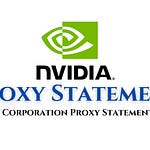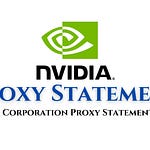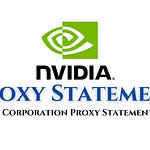NVIDIA 2018 Annual Review
Source: nVidia Proxy Statement for Stockholders Annual Report 2018
Key Themes and Important Ideas:
This annual review from 2018 highlights NVIDIA's significant shift from its origins in PC graphics to becoming a leader in the burgeoning field of Artificial Intelligence (AI). The document emphasizes NVIDIA's platform strategy, built around its Graphics Processing Units (GPUs) and the Compute Unified Device Architecture (CUDA), allowing them to serve diverse, high-growth markets. Financial details regarding revenue streams, executive compensation, and legal considerations are also prominent.
Main Points and Key Facts:
Evolution and Focus on AI: NVIDIA, which started in computer graphics 25 years prior, has successfully pivoted to address major technological trends, particularly AI and self-driving cars. The document states, "What began 25 years ago with our work in computer graphics has evolved to address some of the most important technological trends the world has ever seen. From gaming to AI and from self-driving cars..."
GPU Computing Platform Strategy: A core theme is NVIDIA's "platform strategy, bringing together hardware, system software, programmable algorithms, libraries, systems, and services to create unique value for the markets we serve." This is unified by their GPUs and CUDA architecture, allowing them to cater to multiple markets with the same underlying technology through different software stacks.
Target Markets: NVIDIA's platform approach targets four main markets: Gaming, Professional Visualization, Datacenter, and Automotive.
Gaming: GeForce GPUs are specifically branded for this market. Revenue from GeForce GPU products for gaming increased over 20% in Fiscal Year 2018 compared to Fiscal Year 2017.
Professional Visualization: Quadro GPUs are used by designers for visual effects and product design. Revenue in this segment increased by 12%.
Datacenter: Tesla, GRID, and DGX products cater to AI data scientists and big data researchers. Datacenter revenue showed significant growth of 133%, driven by demand for deep learning training, accelerated GPU computing, and virtualization platforms. NVIDIA also offers the NGC (NVIDIA GPU Cloud) for AI developers.
Automotive: Tegra processors are used in automobiles, autonomous machines, and smart devices. NVIDIA DRIVE PX Pegasus is highlighted as a supercomputer for Level 5 driverless vehicles, capable of 320 TOPS of deep learning performance. Tegra Processor revenue increased by 86%.
Revenue Performance: Total revenue in Fiscal Year 2018 was $9,714 million, a 41% increase from $6,910 million in Fiscal Year 2017. Both the GPU and Tegra Processor segments showed strong revenue growth.
Executive Leadership: Jen-Hsun Huang is identified as the co-founder, president, chief executive officer, and a board member since 1993. He is credited with taking NVIDIA "from a startup to a world leader in visual computing."
Intellectual Property Protection: NVIDIA relies on a combination of patents, trademarks, trade secrets, and licensing arrangements to protect its intellectual property. They have numerous issued and pending patents related to their products and technology. They also mention the risk of intellectual property infringement lawsuits, citing ongoing cases with Polaris and ZiiLabs.
Stock and Equity Compensation: The document details NVIDIA's equity incentive plans, including the 2007 Equity Incentive Plan and the 2012 Employee Stock Purchase Plan. These plans involve the granting of stock options, restricted stock units (RSUs), and performance stock units (PSUs) to employees, directors, and consultants. Information regarding the beneficial ownership of shares by NEOs (Named Executive Officers) and directors is provided.
Share Repurchase Program: The Board of Directors authorized a share repurchase program, with $1.82 billion remaining authorized for repurchase through December 2020 as of January 28, 2018. They intended to return $1.25 billion to shareholders in Fiscal Year 2019 through dividends and repurchases.
Financial Health: Key financial metrics are presented, including total assets ($11,241 million), cash, cash equivalents, and marketable securities ($7,108 million), and total shareholders' equity ($7,471 million) as of January 28, 2018.
Supply Chain and Inventory Management: As a fabless semiconductor company, NVIDIA relies on third-party manufacturers and manages inventory based on demand forecasts, acknowledging the risks associated with inaccurate estimations.
Customer Programs: NVIDIA utilizes customer programs, including rebates and marketing development funds (MDFs), accounted for as a reduction of revenue.
Supporting Details and Quotes:
"NVIDIA DRIVE PX Pegasus will enable Level 5 driverless vehicles. A supercomputer the size of a license plate, Pegasus delivers 320 TOPS of deep learning performance."
"Our strategy is to target markets where GPUs deliver order-of-magnitude performance advantages relative to legacy approaches."
"Datacenter revenue, including Tesla, GRID and DGX, increased 133%, reflecting strong demand from hyperscale and cloud customers for deep learning training and accelerated GPU computing..."
"We rely primarily on a combination of patents, trademarks, trade secrets, employee and third-party nondisclosure agreements, and licensing arrangements to protect our intellectual property..."
Regarding MY PSUs granted in Fiscal 2016: "NVIDIA’s TSR over this three-year period was 971%, representing the 100th percentile of companies in the S&P 500, resulting in the maximum number of MY PSUs becoming eligible to vest..."
As of January 28, 2018, "we were authorized... to repurchase additional shares of our common stock up to $1.82 billion through December 2020."
Potential Implications/Further Questions:
How have the legal cases mentioned (Polaris, ZiiLabs) progressed since 2018 and what has been their impact?
How have NVIDIA's revenue streams from their four target markets evolved since 2018?
What has been the impact of the share repurchase program and dividend payments on shareholder value since 2018?
How has the competitive landscape in the AI and automotive markets changed since 2018, and how has NVIDIA adapted its strategy?
What is the current status and impact of NVIDIA's intellectual property portfolio?













Share this post